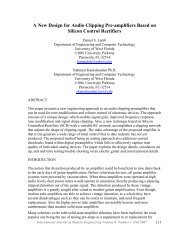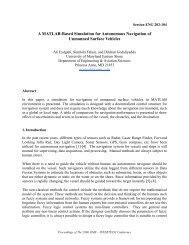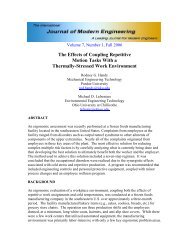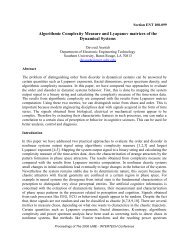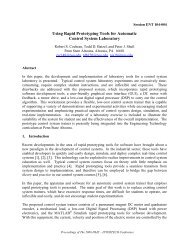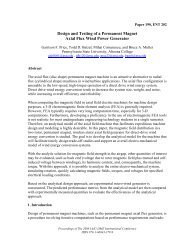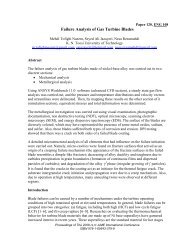WIP: A Study on the Development of Endodontic Micro Robot - IJME
WIP: A Study on the Development of Endodontic Micro Robot - IJME
WIP: A Study on the Development of Endodontic Micro Robot - IJME
You also want an ePaper? Increase the reach of your titles
YUMPU automatically turns print PDFs into web optimized ePapers that Google loves.
e embedded in <strong>the</strong> micro robot. Six micro actuators will be used to c<strong>on</strong>trol <strong>the</strong> five axes<br />
(five degrees <strong>of</strong> freedom) and <strong>the</strong> <strong>on</strong>/<strong>of</strong>f spindle <strong>of</strong> <strong>the</strong> tool. Each actuator is<br />
independently c<strong>on</strong>trolled by a digital NC c<strong>on</strong>troller. The c<strong>on</strong>troller should react <strong>the</strong><br />
sensor signal quickly, typically in a few millisec<strong>on</strong>ds. Choosing embedded<br />
microc<strong>on</strong>trollers or cord c<strong>on</strong>nected c<strong>on</strong>troller is to be determined by fur<strong>the</strong>r research.<br />
Auxiliary functi<strong>on</strong>s will be provided. These functi<strong>on</strong>s include: an irrigati<strong>on</strong> nozzle for<br />
cleaning, a vacuum sucti<strong>on</strong> cup for chip and waste fluid removal, and/or optical fibers for<br />
lighting, imaging and observati<strong>on</strong>. A manual remote c<strong>on</strong>trol will be provided for <strong>the</strong><br />
clinician, but a fully automatic operati<strong>on</strong> with computer-aided treatment procedure<br />
planning and c<strong>on</strong>trol is <strong>the</strong> ultimate goal for a zero-defect operati<strong>on</strong>. An interface system<br />
will be provided for <strong>the</strong> clinician to interact with <strong>the</strong> machine c<strong>on</strong>trol.<br />
The computer-aided treatment process planning system, with functi<strong>on</strong>s similar to<br />
CAD/CAM programs in <strong>the</strong> machinery industry, will generate <strong>the</strong> standard NC codes (G<br />
codes and M codes) as output from a computer aided design file. These codes will c<strong>on</strong>trol<br />
<strong>the</strong> movements <strong>of</strong> <strong>the</strong> robot through an NC digital c<strong>on</strong>troller. This computer prescripti<strong>on</strong><br />
program is being developed to automatically select <strong>the</strong> appropriate tool and to determine:<br />
(1) <strong>the</strong> tool’s starting point, positi<strong>on</strong>, and directi<strong>on</strong>, (2) <strong>the</strong> tool’s path, (3) <strong>the</strong> tool’s<br />
stopping point, (4) <strong>the</strong> cutting parameters, such as speed and feed, and (5) <strong>the</strong> geometry<br />
<strong>of</strong> <strong>the</strong> 3-D tooth model after treatment. The computer program will plan <strong>the</strong> sequence <strong>of</strong><br />
<strong>the</strong> operati<strong>on</strong>s using a variety <strong>of</strong> tools and moti<strong>on</strong> c<strong>on</strong>trol parameters to complete <strong>the</strong><br />
preparati<strong>on</strong> <strong>of</strong> <strong>the</strong> root canal. An optimizati<strong>on</strong> program will be integrated into this autoprescripti<strong>on</strong><br />
program to minimize <strong>the</strong> removal <strong>of</strong> tooth structure and to eliminate<br />
unnecessary tool change.<br />
CONCLUSION<br />
The development <strong>of</strong> an endod<strong>on</strong>tic micro robot is <strong>the</strong> center piece <strong>of</strong> Advanced<br />
Endod<strong>on</strong>tic Technology <strong>Development</strong>. Compared to c<strong>on</strong>venti<strong>on</strong>al access methods for<br />
root canal treatment, this research presents a less invasive method using automated access<br />
and canal preparati<strong>on</strong> during endod<strong>on</strong>tic <strong>the</strong>rapy. The automated treatment using micro<br />
endod<strong>on</strong>tic robot prevents problems identified with c<strong>on</strong>venti<strong>on</strong>al techniques (e.g.,<br />
inadequate opening, overzealous tooth removal), and provides a safe, accurate, and<br />
reliable root canal treatment for patients. With <strong>on</strong>-line m<strong>on</strong>itoring and intelligent c<strong>on</strong>trol,<br />
this machine will perform <strong>the</strong> automatic probing, drilling, cleaning, and filling <strong>of</strong> a root<br />
canal. The success <strong>of</strong> <strong>the</strong> robot fabricati<strong>on</strong> and integrati<strong>on</strong> into <strong>the</strong> Advanced Endod<strong>on</strong>tic<br />
Technology <strong>Development</strong> plan will change <strong>the</strong> traditi<strong>on</strong>al method <strong>of</strong> root canal treatment.<br />
The new method will be a science and technology based automati<strong>on</strong> system, and will<br />
result in <strong>the</strong> microelectr<strong>on</strong>ic mechanical (MEMS) technology being utilized in a new<br />
applicati<strong>on</strong> area in endod<strong>on</strong>tics.<br />
This paper described <strong>the</strong> preliminary development <strong>of</strong> endod<strong>on</strong>tic micro robot for root<br />
canal treatment, including specificati<strong>on</strong> and requirements, mechanical design, and<br />
c<strong>on</strong>troller systems. Fur<strong>the</strong>r study is still needed, especially in <strong>the</strong> micro sensor and<br />
Internati<strong>on</strong>al Journal <strong>of</strong> Modern Engineering Volume 8, Number 1 Fall 2007 32



